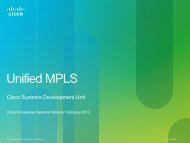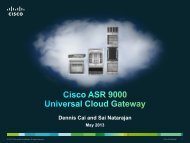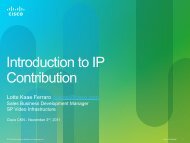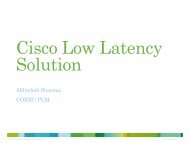Presentation - Cisco Knowledge Network
Presentation - Cisco Knowledge Network
Presentation - Cisco Knowledge Network
- No tags were found...
Create successful ePaper yourself
Turn your PDF publications into a flip-book with our unique Google optimized e-Paper software.
<strong>Cisco</strong> TechAdvantage WebinarsNext Gen MVPNRabiul HasanUjjwal VinodFollow us@GetYourBuildOn© 2013 <strong>Cisco</strong> and/or its affiliates. All rights reserved. 1
© 2011 <strong>Cisco</strong> and/or its affiliates. All rights reserved.<strong>Cisco</strong> Confidential 3
Consumer Internet Video traffic will reach 20 EB/month in 2016Mobile Video20.138%Mobile Video14.86%Internet PVR10.511%Ambient Video7.0518%Live Internet TV4.827%Internet Video2.54x Growth, 34% CAGR2011 2012 2013 2014 2015 2016Consumer Internet Video TrafficSource: <strong>Cisco</strong> Visual <strong>Network</strong>ing Index—Forecast, 2011-2016© 2011 <strong>Cisco</strong> and/or its affiliates. All rights reserved. <strong>Cisco</strong> Confidential 4
IPv4IPv6IPv4IPv6ServiceNativeNativemVPNmVPNC-Multicast SignalingPIMPORTBGPCore Tree SignalingPIM(pt-mpt)mLDP(pt-mpt | mpt-mpt)P2MP TE(pt-mpt)Encapsulation/ForwardingIP/GRELSM© 2011 <strong>Cisco</strong> and/or its affiliates. All rights reserved. <strong>Cisco</strong> Confidential 5
1IP multicast packets are transported usingMPLS encapsulation.2MPLS encoding for LSM documented inRFC-5332.3Unicast and Multicast share the same labelspace.4MPLS protocols RSVP-TE and LDP aremodified to support P2MP and MP2MP LSPs.© 2011 <strong>Cisco</strong> and/or its affiliates. All rights reserved. <strong>Cisco</strong> Confidential 6
IPTV / Internet multicast transportVPLS LSM• mLDP in-band-signaling• 1:1 mapping between IP multicast flow and LSP• non-VPN• Multicast over VPLS VPN• P2MP mLDP or RSVP TE for P-tree• Dynamic tunnelsCarriers Carrier service• A provider offering services to another providerMVPN (RFC-6037 i.e. RosenModel)• MP2MP mLDP for MI-PMSI ( i.e. default MDT)• P2MP mLDP or RSVP TE for MS-PMSI ( i.e. data MDT)MVPN (Dynamic partitioned MDT)• Dynamic model of above.• Using mLDP MP2MP for the dynamic MDT.© 2011 <strong>Cisco</strong> and/or its affiliates. All rights reserved. <strong>Cisco</strong> Confidential 77
• Growing Demand• Growing number of MPLS-VPN customers have IP Multicast Traffic• Volume and Type of multicast Traffic• Expected to grow to a significant share of the total traffic• Increasing demand for video, rich-media• Evolution of Label Switched Multicast• Extend MPLS-VPN service offering to include support for multicast traffic• Same architecture/Model as 4364 VPN unicast• Re-use the 4364 unicast mechanisms with extensions• BGP as the Signaling Protocol for all services• No PIM in the Core• Same flexibility and scalability of 4364 VPN unicast© 2011 <strong>Cisco</strong> and/or its affiliates. All rights reserved. <strong>Cisco</strong> Confidential 8
© 2011 <strong>Cisco</strong> and/or its affiliates. All rights reserved.<strong>Cisco</strong> Confidential 9
PE2CE2Site-2SxSxSite-1RxCE1PE1PAYLOAD C-header P-headerSP-CLOUDPE3CE3RxSite-3RxSxPE2CE mcastPE2PE routing(uni/mcast/label-swap)PE2CE mcastCE2CE mcastCLASSICAL-supportNG-supportENCAPSULATION OPTIONS IN CORE IP/GRE MPLSOPTIONS TO DISCOVER PEs PIM BGPCORE/PROVIDER-TREE PIM-ASM/SSM/BIDIR mLDP, P2MP-TE, INGRESS-REPLICATIONC-MCAST ROUTING OPTIONS (PE-PE) PIM BGPPE-CE MCAST ROUTING PIM-ASM/SSM/BIDIR mLDP, BGPBINDING BTW FLOW & P-TREE PIM BGP© 2011 <strong>Cisco</strong> and/or its affiliates. All rights reserved. <strong>Cisco</strong> Confidential 10
CE2Site-2SxRxPE2PE3CE3Site-3SxSxSite-1CE1PE1RxRxRxPE4CE4Site-4Sxv4/6PIMMULTICAST CORE PROTOCOL OPTIONS1) PIM (SM, SSM, BIDIR)2) MPLS mLSP using mLDP3) MPLS mLSP using RSVP P2MP-TELDP, RSVP-TE, v4PIM, mLDP, P2MP-RSVP-TECORE/PROVIDER TREE1) P2MP2) MP2MP3) P2Pv4/6PIMMODEL1) ROSEN: Default MDT (MI-PMSI) [MUST], On-Demand Data MDT (S-PMSI) [OPTIONAL]2) PARTITIONED: On-Demand Partition MDT(MS-PMSI) [MUST], On-Demand Data MDT (S-PMSI) [OPTIONAL]3) IN-BAND: On-Demand core-tree per-VRF, per-S,GAUTO-DISCOVERY1) [RFC-6037] PIM (ASM, SSM, BIDIR) + BGP2) [RFC-6514] BGPC-MULTICAST ROUTING OPTIONS1) PIM (ASM, SSM, BIDIR)2) BGP© 2011 <strong>Cisco</strong> and/or its affiliates. All rights reserved. <strong>Cisco</strong> Confidential 11
NLRI1) MCAST-VPN NLRIROUTE TYPE[1 BYTE]LENGTH[1 BYTE]1) INTRA-AS I-PMSI A-D ROUTE [Originated by ALL MVPN PEs]2) INTER-AS I-PMSI A-D ROUTE [Originated by MVPN ASBRs]3) S-PMSI A-D ROUTE [Originated by SENDER PEs]4) LEAF A-D ROUTE [Originated by TAIL PEs]5) SOURCE ACTIVE A-D ROUTE [Originated by ACTIVE-SOURCE/RP PEs]6) SHARED TREE JOIN ROUTE [Originated by RECEIVER PEs]7) SOURCE TREE JOIN ROUTE [Originated by RECEIVER PEs]ROUTE TYPE SPECIFIC[VAR LENGTH]ATTRIBUTES1) PMSI TUNNEL ATTRIBUTE [The PTA is used in conjunction with: Intra-AS I-PMSI A-D, Inter-AS I-PMSI A-D, S-PMSI A-D, Leaf A-D]2) PE DISTINGUISHER LABEL ATTRIBUTE [PDL is distributed with Intra-AS I-PMSI A-D and/or S-PMSI A-D routes]3) SOURCE AS EXTENDED COMMUNITY ATTRIBUTE [AS SPECIFIC extended community. Specifies the originator AS of a route]4) VRF ROUTE IMPORT EXTENDED COMMUNITY ATTRIBUTE [IP ADDRESS SPECIFIC extended community. Specifies the originatorPE of a route]For YourReference© 2011 <strong>Cisco</strong> and/or its affiliates. All rights reserved. <strong>Cisco</strong> Confidential 12
[Local Label] [Outgoing Label] [Prefix or Tunnel Id] [Bytes Label switched] [Outgoing interface] [Next Hop]2113 1862 22.22.22.22 0 [39] 187469 Te3/0/1 13.1.1.3[Local Label] [Outgoing Label] [Prefix or Tunnel Id] [Bytes Label switched] [Outgoing interface] [Next Hop]5851 1912 22.22.22.22 0 [39] 187469 Te3/0/0 13.1.1.33631 22.22.22.22 0 [39] 187491 Te3/0/1 14.1.1.37192 22.22.22.22 0 [39] 187480 Te3/0/2 15.1.1.37089 22.22.22.22 0 [39] 187445 Te3/0/3 16.1.1.3© 2011 <strong>Cisco</strong> and/or its affiliates. All rights reserved. <strong>Cisco</strong> Confidential 13
© 2011 <strong>Cisco</strong> and/or its affiliates. All rights reserved.<strong>Cisco</strong> Confidential 14
Default MDTVRF1 configured withDefault group addressPE1PE2PE7DEFAULTMDTPE3PE6PE4PE5© 2011 <strong>Cisco</strong> and/or its affiliates. All rights reserved. <strong>Cisco</strong> Confidential 15
Default MDT(Sx1, G1)VRF1 configured withDefault group addressPE1PE2PE7DEFAULTMDTPE3PE6Receiver1(Sx1, G1)PE4PE5Receiver2(Sx1, G1)© 2011 <strong>Cisco</strong> and/or its affiliates. All rights reserved. <strong>Cisco</strong> Confidential 16
Default MDTPE11(Sx1, G1), 8 MbpsVRF1 configured withDefault group addressPE2PE7DEFAULTMDTPE3PE6Receiver1(Sx1, G1)PE4PE5Receiver2(Sx1, G1)© 2011 <strong>Cisco</strong> and/or its affiliates. All rights reserved. <strong>Cisco</strong> Confidential 17
Data MDTPE11(Sx1, G1), 8 MbpsVRF1 configured withDefault group addressPE2PE7THRESHOLD of 5 Mbpsis configured at PE1.PE3DEFAULTMDTDATAMDTPE6NOTE: Each stream inparticular VRF withbandwidth in use >=THRESHOLD, should beswitched to DATA MDTReceiver1(Sx1, G1)PE4PE5Receiver2(Sx1, G1)© 2011 <strong>Cisco</strong> and/or its affiliates. All rights reserved. <strong>Cisco</strong> Confidential 18
Data MDTPE11(Sx1, G1), 8 MbpsVRF1 configured withDefault group addressPE2PE7THRESHOLD of 5 Mbpsis configured at PE1.PE3DEFAULTMDTDATAMDTPE6NOTE: Each stream inparticular VRF withbandwidth in use >=THRESHOLD, should beswitched to DATA MDTReceiver1(Sx1, G1)PE4PE5Receiver2(Sx1, G1)© 2011 <strong>Cisco</strong> and/or its affiliates. All rights reserved. <strong>Cisco</strong> Confidential 19
Aggregated Data MDT1(Sx1, G1), 8 MbpsVRF1 configured withDefault group address(Sx2, G2)PE1PE2PE7THRESHOLD of 5 Mbpsis configured at PE1.PE3DEFAULTMDTDATAMDTPE6NOTE: Each stream inparticular VRF withbandwidth in use >=THRESHOLD, should beswitched to DATA MDTReceiver1(Sx1, G1)PE4PE5Receiver3(Sx2, G2)Receiver2(Sx1, G1)© 2011 <strong>Cisco</strong> and/or its affiliates. All rights reserved. <strong>Cisco</strong> Confidential 20
Aggregated Data MDT21(Sx1, G1), 8 MbpsVRF1 configured withDefault group address(Sx2, G2), 8 MbpsPE1PE2PE7THRESHOLD of 5 Mbpsis configured at PE1.DEFAULTMDTDATAMDTNOTE: Each stream inparticular VRF withbandwidth in use >=THRESHOLD, should beswitched to DATA MDTPE3PE6Receiver1(Sx1, G1)PE4PE5Receiver3(Sx2, G2)Receiver2(Sx1, G1)© 2011 <strong>Cisco</strong> and/or its affiliates. All rights reserved. <strong>Cisco</strong> Confidential 21
Partitioned MDT(Sx1, G1)VRF1 configuredPE1PE2PE7PARTITIONEDMDTPE3PE6Receiver1(Sx1, G1)PE4PE5© 2011 <strong>Cisco</strong> and/or its affiliates. All rights reserved. <strong>Cisco</strong> Confidential 22
Partitioned MDT1(Sx1, G1), 8 MbpsVRF1 configuredPE1PE2PE7PARTITIONEDMDTPE3PE6Receiver1(Sx1, G1)PE4PE5© 2011 <strong>Cisco</strong> and/or its affiliates. All rights reserved. <strong>Cisco</strong> Confidential 23
Partitioned MDT1(Sx1, G1), 8 MbpsVRF1 configuredPE1PE2PE7PARTITIONEDMDTPE3PE6Receiver1(Sx1, G1)PE4PE5Receiver2(Sx1, G1)© 2011 <strong>Cisco</strong> and/or its affiliates. All rights reserved. <strong>Cisco</strong> Confidential 24
Partitioned MDT21(Sx1, G1), 8 MbpsVRF1 configured(Sx2, G2), 8 MbpsPE1PE2PE7PARTITIONEDMDTPE3PE6Receiver1(Sx1, G1)PE4PE5Receiver3(Sx2, G2)Receiver2(Sx1, G1)© 2011 <strong>Cisco</strong> and/or its affiliates. All rights reserved. <strong>Cisco</strong> Confidential 25
Partitioned MDT21(Sx1, G1), 8 MbpsVRF1 configured(Sx2, G2), 8 MbpsPE1(Sx3, G3)PE2PARTITIONEDMDTPE7Receiver4(Sx3, G3)PARTITIONEDMDTPE3PE6Receiver1(Sx1, G1)PE4PE5Receiver5(Sx3, G3)Receiver3(Sx2, G2)Receiver2(Sx1, G1)© 2011 <strong>Cisco</strong> and/or its affiliates. All rights reserved. <strong>Cisco</strong> Confidential 26
Partitioned MDT21(Sx1, G1), 8 MbpsVRF1 configured3(Sx2, G2), 8 MbpsPE1(Sx3, G3), 8 MbpsPE2PARTITIONEDMDTPE7Receiver4(Sx3, G3)PARTITIONEDMDTPE3PE6Receiver1(Sx1, G1)PE4PE5Receiver5(Sx3, G3)Receiver3(Sx2, G2)Receiver2(Sx1, G1)© 2011 <strong>Cisco</strong> and/or its affiliates. All rights reserved. <strong>Cisco</strong> Confidential 27
Partition MDT21(Sx1, G1), 8 MbpsVRF1 configured3(Sx2, G2), 8 MbpsPE1(Sx3, G3), 8 MbpsPE2PARTITIONEDMDTPE7Receiver4(Sx3, G3)PARTITIONEDMDTPE3PE6PARTITIONED to DATAMDT switchover isapplicable here also,which is very similar toDEFAULT to DATA MDTswitchover.Receiver1(Sx1, G1)PE4PE5Receiver5(Sx3, G3)Receiver3(Sx2, G2)Receiver2(Sx1, G1)© 2011 <strong>Cisco</strong> and/or its affiliates. All rights reserved. <strong>Cisco</strong> Confidential 28
# TREE TYPE1 INCLUSIVE P-TREE- Multi-Directional Inclusive Provider Multicast Service Instance (MI-PMSI),like Default MDT.- Using INTRA-AS I-PMSI AD ROUTE.- One per-VRF.- Created on provisioning VRF and related attributes.2 SELECTIVE P-TREE- Selective Provider Multicast Service Instance (S-PMSI), like Data MDT.- Using S-PMSI AD ROUTE.- One per-VRF, per-(S,G).- Dynamically created for (S,G) once configured threshold for per streamin particular VRF is reached.3 AGGREGATED SELECTIVE P-TREE- Selective Provider Multicast Service Instance (S-PMSI), like AggregatedData MDT.- Using S-PMSI AD ROUTE.- One per-VRF, multiple-(S,G).4 PARTITIONED P-TREE- S-PMSI (like Partitioned MDT).- Multiple (S,G) streams are connected to same Selective-P-Tree whenmax allowed # of Selective-P-Tree for particular VRF is reached and stillunattached (S,G) streams exist.- Using S-PMSI AD ROUTE for (*,*).- One per-VRF, per-INGRESS-PE-NODE.- Dynamically created when receiver for particular (S,G) comes up.© 2011 <strong>Cisco</strong> and/or its affiliates. All rights reserved. <strong>Cisco</strong> Confidential 29
© 2011 <strong>Cisco</strong> and/or its affiliates. All rights reserved.<strong>Cisco</strong> Confidential 30
P2MP RSVP-TEmLDPThe egress (leaf) receives a PIM Join.The Leafs sends a BGP A-D leaf to notify the ingress PEThe egress (leaf) receives a PIM Join.The leaf sends a mLDP label mapping to the ingress PE.The ingress sends RSVP-TE PATH messages to the leavesThe leaves respond with RSVP-TE RESV messagesThe core router received 6 updates.The core router received 3 update messages© 2011 <strong>Cisco</strong> and/or its affiliates. All rights reserved. <strong>Cisco</strong> Confidential 31
P2MP RSVP-TEmLDPControl Plane: 3 P2P sub-LSPs from the ingress to the leavesControl Plane: 1 P2MP LSPData Plane: The 3 sub-LSP are merged into one P2MP for replicationForwarding Plane: 1 P2MP LSPP: one state for each individual leaf, total 3 in example; 12 path/resv msgIngress PE: 3 LSPs, 6 path/resv msgWhen a leaf wants to leave, control-msg is sent all the way to the ingressPE to remove the LSPP: 1 P2MP FEC (independent of the number of leaves), 4 control msgsPE: 1 P2MP FEC (independent of the number of leaves), 1 controlmsgWhen a leaf wants to leave, the message is only sent to the nextbranch point, not all the way to ingress PE© 2011 <strong>Cisco</strong> and/or its affiliates. All rights reserved. <strong>Cisco</strong> Confidential 32
© 2011 <strong>Cisco</strong> and/or its affiliates. All rights reserved.<strong>Cisco</strong> Confidential 33
UPSTREAM MULTICAST HOP© 2011 <strong>Cisco</strong> and/or its affiliates. All rights reserved.<strong>Cisco</strong> Confidential 34
PE2PE1PE3PS1PE4 INSTALLED ROUTES: Routes installed in unicast RIB. INSTALLED PATHS: Multiple Paths associated with each installed route.These are the ones selected by BGP, by running its best-path selectionalgorithm and the maximum-paths configuration under BGP. BGP PATHS: It is possible for BGP to have additional paths, which are notinstalled in RIB. This full set of paths in the BGP database, is called as "BGP-Paths". SELECTED PATH: When PIM receives the Installed-Paths for a Source/RP, itselects one of the paths for sending (*,G) and (S,G) Joins Upstream. This iscalled as "Selected-Path". UMH Selection options available for the Customer.• Hash of Installed-Paths: No additional resources are required in BGPor RIB, to support this option.• Highest PE Address: Highest PE Address among the BGP-paths istracked.• Hash of BGP-Paths: Additional resources are required in BGP orRIB, to support this option.PE1VRF-RED:(S1,G1) JOINVRF-RED:(S1,G2) JOIN© 2011 <strong>Cisco</strong> and/or its affiliates. All rights reserved. <strong>Cisco</strong> Confidential 35
SWITCHING FROM SHARED TREE TO SOURCE C-TREE© 2011 <strong>Cisco</strong> and/or its affiliates. All rights reserved.<strong>Cisco</strong> Confidential 36
RPSRCSource Tree Join C-multicast routegenerated by PE3PE1MI-PMSIPE2MI-PMSI2XPE5(C*,CG)(C*,CG)PE32X(C*,CG)2XPE4If it is desirable to suppress receiving duplicate traffic, then it is necessaryto choose a single forwarder PE for (CS,CG).© 2011 <strong>Cisco</strong> and/or its affiliates. All rights reserved. <strong>Cisco</strong> Confidential 37
When, as a result of receiving a Source Tree Join C-multicast route for (CS,CG) from some other PE the local PE addseither the S-PMSI or the I-PMSI to the outgoing interface list of the (CS,CG) state, the local PE MUST originate a SourceActive A-D route. The Source Active A-D route is propagated to all the PEs of the MVPN.RPSRCPE1PE2Source Tree Join C-multicast routegenerated by PE3MI-PMSISOURCE ACTIVEA-D ROUTEPE5(C*,CG)(C*,CG)PE3(C*,CG)PE4© 2011 <strong>Cisco</strong> and/or its affiliates. All rights reserved. <strong>Cisco</strong> Confidential 38
RPSRCIf matching (C*,CG) is found at PE which received“Source-Active A-D Route”, PE sets up its forwardingpath to receive (CS,CG) traffic from the tunnel theoriginator of the selected Source Active A-D route usesfor sending (CS,CG).PE1PE2Source Tree Join C-multicast routegenerated by PE3MI-PMSISOURCE ACTIVEA-D ROUTEPE5(C*,CG)(C*,CG)PE3(C*,CG)PE4© 2011 <strong>Cisco</strong> and/or its affiliates. All rights reserved. <strong>Cisco</strong> Confidential 39
But this 2X traffic is only for transientduration, see how, next………RPSRCPE1PE2Source Tree Join C-multicast routegenerated by PE3PE32XMI-PMSISOURCE ACTIVEA-D ROUTE2XPE42XPE5(C*,CG)(C*,CG)(C*,CG)© 2011 <strong>Cisco</strong> and/or its affiliates. All rights reserved. <strong>Cisco</strong> Confidential 40
If { ((OIF for the (C*,CG) entry in the MVPN-TIB on the PE contains I-PMSI) OR(OIF for the (C*,CG) entry in the MVPN-TIB on the PE contains S-PMSI)) AND(The PE does not originate the Source Tree Join C-multicast route for CS,CG)}{The PE MUST transition the (CS,CG,rpt) downstream state machine onI-PMSI/S-PMSI to the Prune state (Conceptually, the C-PIM state machineon the PE will act "as if" it had received Prune (CS,CG,rpt) on I-PMSI/S-PMSI,without actually having received one).}RPSRCPE1PE2Source Tree Join C-multicast routegenerated by PE3PE32XMI-PMSISOURCE ACTIVEA-D ROUTE2XPE42XPE5(C*,CG)(C*,CG)(C*,CG)© 2011 <strong>Cisco</strong> and/or its affiliates. All rights reserved. <strong>Cisco</strong> Confidential 41
RPSRCPE1PE2PE5(C*,CG)(C*,CG)PE3(C*,CG)PE4© 2011 <strong>Cisco</strong> and/or its affiliates. All rights reserved. <strong>Cisco</strong> Confidential 42
PIM-SM WITHOUT INTER-SITE SHARED C-TREES© 2011 <strong>Cisco</strong> and/or its affiliates. All rights reserved.<strong>Cisco</strong> Confidential 43
A PE can obtain information about active multicast sources within a given MVPN in a variety of ways:1) One way is for the PE to act as a fully functional customer RP (C-RP) for that MVPN.2) Another way is to use PIM Anycast RP procedures to convey information about active multicast sources from one or more of the MVPN C-RPs to the PE.3) Yet another way is to use MSDP [MSDP] to convey information about active multicast sources from the MVPN C-RPs to the PE.FHRREGISTERINGPIM JOIN(CS,CG)RPPE1PE2When a PE using any of the above methods first learns of a new(multicast) source within that MVPN, the PE constructs a SourceActive A-D route and sends this route to all other PEs that haveone or more sites of that MVPN connected to them. The SourceActive A-D route is propagated to all the PEs of the MVPN.Source Tree Join C-multicast routeSOURCE ACTIVE A-DROUTEPE5(CS,CG)(C*,CG)(C*,CG)(CS,CG)PE3PE4© 2011 <strong>Cisco</strong> and/or its affiliates. All rights reserved. <strong>Cisco</strong> Confidential 44
© 2011 <strong>Cisco</strong> and/or its affiliates. All rights reserved.<strong>Cisco</strong> Confidential 45
For YourReferencePIM1) DEFAULT MDT using PIM without BGP-AD [ I, X ]2) DEFAULT MDT using PIM with BGP-AD [ I, X ]3) DEFAULT MDT using PIM with BGP-AD & c-mcast routing [ I, X ]I: IOS/XE SUPPORTED (15.3(1)S, 3.8S)X : IOS-XR SUPPORTED (4.3.0)P2MP mLDP1) Global In-Band signaling with mLDP [ I, X ]2) VRF in-band-signaling with mLDP [ I, X ]3) DEFAULT MDT using P2MP mLDP with BGP-AD [ X ]4) DEFAULT MDT using P2MP mLDP with BGP-AD & c-mcast routing [ X ]5) PARTITIONED MDT using P2MP MLDP with BGP-AD [ X ]6) PARTITIONED MDT using P2MP MLDP with BGP-AD & c-mcast routing[ X]PROFILESMP2MP mLDP1) DEFAULT MDT using MP2MP mLDP without BGP-AD [ I, X ]2) DEFAULT MDT using MP2MP mLDP with BGP-AD [ I, X ]3) DEFAULT MDT using MP2MP mLDP with BGP-AD & c-mcast routing [ I, X ]4) PARTITIONED MDT using MP2MP MLDP without BGP-AD [ X ]5) PARTITIONED MDT using MP2MP MLDP with BGP-AD [ X ]6) PARTITIONED MDT using MP2MP MLDP with BGP-AD & c-mcast routing [X]P2MP RSVP-TE1) Global P2MP-TE [ I, X ]2) P2MP-TE with BGP-AD in VRF context [ X ]3) DEFAULT MDT using P2MP-TE with BGP-AD [ X ]4) DEFAULT MDT using P2MP-TE with BGP-AD & c-mcast routing [ X ]© 2011 <strong>Cisco</strong> and/or its affiliates. All rights reserved. <strong>Cisco</strong> Confidential 46
• Thank you!• Please complete the post-event survey• Join us for upcoming webinars:Register: www.cisco.com/go/techadvantageFollow us@GetYourBuildOn© 2011 <strong>Cisco</strong> and/or its affiliates. All rights reserved. <strong>Cisco</strong> Confidential 47
















